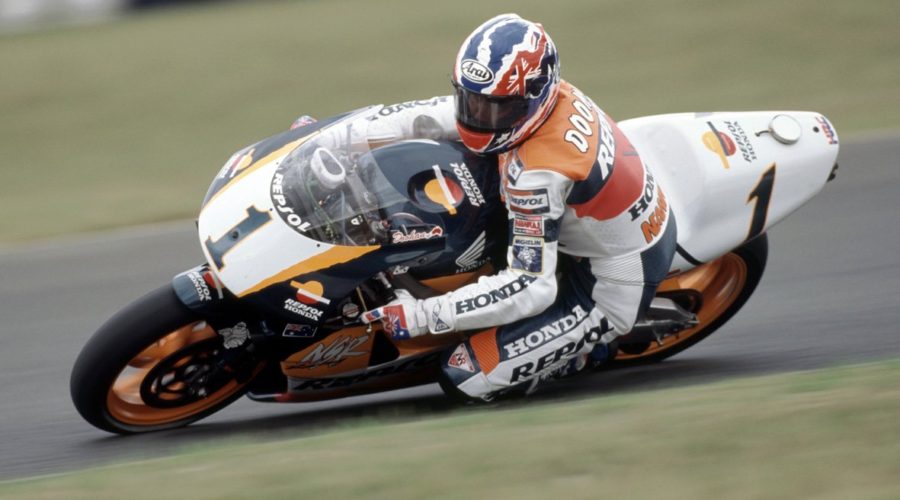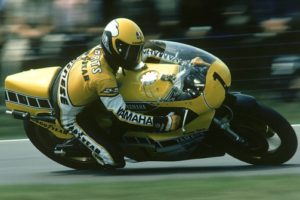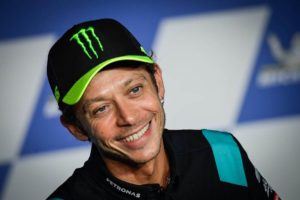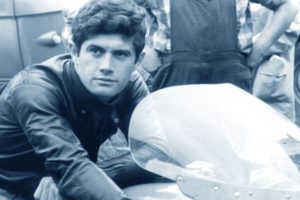Racing’s Greats: Mick Doohan
On his descent from the conquest of Mt. Everest, Edmund Hillary is supposed to have greeted one of his colleagues with the disarming line, “We got the bastard!”
Michael Doohan could have been excused for saying something similar under his helmet on the slow-down lap at Brno on August 21, 1994.
But with his helmet off and facing the official IRTA race winner’s television interview, he didn’t say that.
Doohan has never liked making predictions about winning titles and once said he can’t stand people who carry on that way. What he could do now was answer the question that he’d wanted to duck for the previous four or five races — the question of winning the championship.
“It feels good to actually win it,” he said.
“I didn’t want to talk about it because I hadn’t won it, and I don’t like to talk about something I haven’t got. It feels good to actually clinch it. I’ve been lucky all year with Kevin having some problems. This weekend he couldn’t get his bike working.
“The Honda team has been working hard all year — the Michelins, the Elf fuel, everything — so I owe a lot to a lot of people, especially Dr Costa and the Italian people who helped me back in ’92. There were times then when I wanted to stop. Without them I wouldn’t be here. I wouldn’t have a leg! So I’m happy.”
Doohan had led the 1991 and 1992 World 500 Championships at the halfway point of each season, and had been spoken of as a champion-in-waiting since 1991.

In 1994 Doohan was unstoppable. Mighty Mick won decisively, securing the title with three rounds remaining and equalling Wayne Gardner’s alltime record of the most GP victories by an Australian (18).
The statistics of the ’94 season are impressive. A rostrum finish at every start, which was Mick’s goal. Eight race victories in the first 11 rounds: Shah Alam, Jerez, Salzburgring, Hockenheim, Assen (how sweet!), Mugello, Le Mans and Brno. A stunning six wins in a row in the first six races of the European tour. No 500 grand prix rider has enjoyed a run like that in over two decades.
And to cap it off, there’s a Honda contract for 1995 on Doohan’s terms. Mick reckons Honda gave him the things he wanted without him even having to ask.
People involved at the grand prix coalface often talk of the package that wins a championship. Mick Doohan had it all this year: fitness, attitude, the right bike, consistent tyres, an experienced and loyal crew and that ounce of what we might term champion’s luck.
Check out the video of the French GP if you want evidence of the latter.
Doohan began the year with a certain inner calmness. He was more relaxed than anyone could remember. He’d always said “no worries” and produced the easy, short answers, but that tended to disguise a serious determination, sharp watching eyes and a matching analytical mind.
This year, the sometimes introverted but always determined racer had seemingly found new strength and direction in the pain and trouble of the past two years.
“I felt that maybe as the season progresses it’s going to get harder and we’re going to be sliding a lot. I thought then that barring any sort of injury we should have a reasonable chance.”

The turning point was arguably an extensive testing program in Spain, where Doohan found the engine and suspension feel he’d been missing in the first three races.
“After Japan, we went testing and the bike came back to the way I like it. I felt really good and it was just a matter of keeping the concentration there and just trying to win the races as easily as possible.
“Basically all the races have been hard to win, but (the idea is to) win at the slowest possible pace,” he said.
“Jerez was a difficult race with Kevin. Then in Austria and Germany we had a speed advantage and we kind of used it to our favour.
“And at Assen and Italy, we won at the easiest possible pace. “I’ve just tried not to lose the (championship) lead we had. That had been the biggest thing all year. There had been a bit of pressure on me, but since the bike changed after Japan we had an advantage. Winning in Jerez made it more realistic that we could win the title.”
Doohan said he had a couple of treasured races this season, including his race with Schwantz at Jerez. And he enjoyed Malaysia because he felt the bike wasn’t in the ballpark, yet he was still able to win.
“Then there was a little sentimental sort of feeling to shove it in the face of the doctor in Assen by winning the race there. That was good to win,” he said.
It showed in his general outlook, his style on the machine and the way he raced.
Doohan said he was happy to win the championship for his family, his mostly Anzac team (headed by Jerry Burgess) and his manufacturer, and good too for ending the six-year American domination of the 500 GP class.
“I’m happy that I’ve been able to win it and happy that I’m from Australia,” he said in a follow-up television interview at Brno.
“It’s a relief I was able to win it. It’s something I’ve wanted to do for a long time. In 1991, (that) was the first time I was close to winning it. I was close in 1992 and I broke my leg, and that kind of put a downer on things. Last year was disastrous. And this year, to win so many races and the championship has been great,” he said.

“But most of the credit goes to Honda, because Honda has given me such a great motorcycle, along with the Michelin people. The tyres have been flawless and also the fuel we run. The Elf fuel, when it’s not in court being disputed, it’s the best fuel there is.
“It’s a whole combination of things. This year the Honda has been very good and I’ve just had to ride it. A lot of credit goes to the people behind the scenes.”
Doohan reckoned one of the biggest boosts to his confidence was winning the Malaysian GP on a machine that in his estimation still needed some sorting.
“In Malaysia I didn’t feel the bike was as good as the other guys’. But we won and that gave me a fair bit of confidence that when things start to get loose on the other guys’ bikes they’re not prepared to push them, whereas we’d been sideways all weekend and being sideways doesn’t really bother me.
“From the start of that race all I wanted to do was win it, and we were lucky enough to be able to do it.
“Assen was a mental thing. It really doesn’t bother me going there. I crashed there, but the circuit wasn’t what caused my injury. Sure, I broke my leg. But some guy had somehow got a certificate to work on people and that was what messed my leg up,” he said.
“Really, I don’t like the circuit. I don’t like a few circuits, but going there to race doesn’t bother me. Sure I crashed (in 1992) but it wasn’t like I hit anything on the circuit. I wasn’t even going fast when I crashed. So it was good to actually go there and win, just for the hell of it.
“And I actually quite enjoy it a bit more now. But I still think it’s a street circuit which should be left to race street bikes, not grand prix motorcycles.”
Honda’s former racing boss in Australia, Mick Smith, produced some interesting observations on Doohan’s 1994 effort.

“It’s obvious to me that if anything Honda went back to what would work,” said Smith. “They had a good package in 1992, but in ’93 they had to compromise because of Mick’s leg.
Once he was fit and on top of things, Honda could go back to virtually the 1992 settings.
“Look at Alberto Puig and Alex Criville. They went well too. The Honda is a good package, whereas some of the others are in uncharted waters in their development,” Smith said.
“The bloke I feel sorry for is Daryl Beattie. He could have run second to Mick.”
But what of Doohan’s opposition in 1994?
Kevin Schwantz’s title defence arguably had two dents in its side before the season began.

First he had to re-motivate himself after thinking about Wayne Rainey’s paralysis almost daily in the last few months of 1993. Then he injured himself in a mountain bike accident.
Suzuki added to Schwantz’s woes with differences between the works bike prototypes and the machines it presented for the first few races.
Schwantz had grabbed victories at Suzuka and Donington Park. But even at the Czech GP, the 1993 champion’s assessment of a low qualifying position began with the observation that “the biggest problem is still the motorcycle.”
Yamaha and Team Roberts had a nightmare season by their standards, and surely missed the focus Wayne Rainey had provided in previous years.
What’s more, Yamaha’s 1994 machine had to be parked before the racing began and both riders suffered injuries. Yamaha’s ‘93.5’ model bikes went well at some circuits and were thrashed at others.
Cagiva won a race, which is more than Yamaha managed in the first 11 events. But the Italian machine lacked the consistency and reliability to do justice to John Kocinski’s riding efforts.
In the past two years, seven different riders have won 500 GPs in a season. This year three riders did all the winning in the 11 rounds that decided the championship.
Michael Doohan’s victory this year was Honda’s first 500 championship since Eddie Lawson won in 1989 and, for the record, the first 500 title on a bike with no tobacco sponsorship since 1983.
Honda’s progress in the past three years had been impressive. In 1992 Honda won seven of the 13 races. In ’93 Honda won two of 14 with a limping lead rider and in ’94 it won eight out of the first 11 events.
As Schwantz was quick to acknowledge, Mick Doohan has certainly done his time and paid his championship dues.
“With the experience he had with the bad medical treatment in 1992, I’m happy for him now,” the Texan said.

And so Michael Doohan ended his sixth year of full-time GP competition as a World Grand Prix Champion, the first time the feat has been achieved by an Australian in an even numbered year.
Australia has had four previous world GP champions: Keith Campbell (1957 350 title on a Moto Guzzi), Tom Phillis (1961 125, Honda), Kel Carruthers (1969 250, Benelli) and Wayne Gardner (1987 500, Honda).
Those four won their titles in either their fourth or fifth year on the GP trail. All were GP part-timers for their first few years overseas.
Doohan is our second oldest world GP champion. He turned 29 on June 4, 1994. Campbell was crowned World Champion at age 25, Phillis at 27, Carruthers at 31 and Gardner at 27.
In 1995 Mick Doohan has the opportunity to carve a place in Australian motorcycling history by winning a second world GP championship.
Campbell was robbed of his works ride and then of his life within a year of becoming champion. Phillis .was frustrated in his title defence by team orders. He too was killed within a year of taking the crown.
Carruthers had no works bike for his title defence, but very nearly won in 1970 on a privately entered Yamaha. The problem was finding an ignition system which would hang together.
And Gardner was stymied first by lack of effective pre-season testing in de-bugging his 1988 mount and then by engine failures at Salzburgring and Paul Ricard.

Doohan is certainly keen to win a second crown. He’s already said he aims to do the same next year.
“I know my determination won’t dwindle, because I feel I’ve got to win another title to make it certain. I still enjoy riding the bike and that’s the main thing that keeps me going.”
By Don Cox. Two Wheels, November 1994.


Circus Life is Don’s account of the exploits of a bunch of young Australian motorcycle racers who followed the GP circuit as privateers through Europe in the 1950s. It’s beautifully written, forensically researched and accompanied by some amazing photographs. Don discusses Circus Life with Jay Leno on Jay Leno’s Garage here, and you can order a copy of Circus Life here.




